How Much Did it Cost to Build this Thing?
Here are the numbers for some of the "big ticket" items for this project. Part numbers are from Antique Electronic Supply (www.tubesandmore.com):
P-H1434-22 Cover plate, aluminum, 12"x8" Hammond $7.95
P-H1444-22 Chassis Box, aluminum, 12"x8"x2" Hammond $18.25
P-T125ESE Transformer, Universal Single Ended, Hammond,
15 watt, 80mA $35.95
P-TF22772 Transformer, Power, Fender Replacement,
325-0-325 V, 70mA $52.50
Thursday, December 21, 2006
Friday, August 18, 2006
My son the avatar maker-
You may have noticed the cool guitar playing avatar in my profile box. This was created by my son using Flash and then exported as an animated .gif file. He calls it "play-all-night" and was inspired by somebody who wished they could play their guitar and amp all the time...
Here is another animation he created. I call it:
Rule #4: Don't forget your chopstick when you trouble shoot your amp...

You may have noticed the cool guitar playing avatar in my profile box. This was created by my son using Flash and then exported as an animated .gif file. He calls it "play-all-night" and was inspired by somebody who wished they could play their guitar and amp all the time...
Here is another animation he created. I call it:
Rule #4: Don't forget your chopstick when you trouble shoot your amp...
Tuesday, August 15, 2006
MY NEXT PROJECT
They say that amp building can be habit forming, and it's true. Go here to see pics of my second build:
My Amp Builds
Specs from Firefly combo as outlined at AX84.com Great crunch at reasonable levels.
They say that amp building can be habit forming, and it's true. Go here to see pics of my second build:
My Amp Builds
Specs from Firefly combo as outlined at AX84.com Great crunch at reasonable levels.
Monday, May 15, 2006

FINAL THOUGHTS for "newb" amp builders like me...
Here are some reflections, suggestions and changes concerning the final build:
- If you are a novice at soldering, I would practice first. I know it sounds goofy, but practice on an eyelet board; practice soldering a wire to a tube socket pin. Get the hang of it first. AND buy a de-soldering sucker thing. When you make a mistake (and you will!) and need to de-solder a connection, this device let's you hold a hot iron in one hand while you get the solder hot from your mistake- then with the other hand press a button that sucks the molten solder out of the way to start over again. Much more effective than de-soldering braid.
- I wish I would have left some clearance for some of the components when I initially soldered them to the board. This would have allowed more space to use my iron when I needed to add more wires later.
 Check the schematic and see where you will have more than 2 junctions to solder in an eyelet. A perfect example is at the positive junction of the 40uF cap where you solder the cap lead, the 10k resistor, the red wire to pin 8 of V4 and the blue OT wire. That's 4 wires going into one small eyelet. Plan ahead and leave some space.
Check the schematic and see where you will have more than 2 junctions to solder in an eyelet. A perfect example is at the positive junction of the 40uF cap where you solder the cap lead, the 10k resistor, the red wire to pin 8 of V4 and the blue OT wire. That's 4 wires going into one small eyelet. Plan ahead and leave some space. - Layout- if I could do it over again, I would have orderd my layout differently. Since I was not going to use this chassis in a combo, I probably should have used the photo of the prototype differently. I really should have layed it out upside down and backwards, but since this was my first amp build, I wanted a visual layout exactly like the schematic in the book. A minor detail, but It would have put my OT in a better place and my power switch on the right side instead of the left side as you look at the amp.
- Input/Speaker Jacks- at the suggestion of a friend, I used plastic Cliff jacks instead of Switchcraft type jacks shown in Hunter's book. Tip and ring terminals are different on these type of jacks and I got some help on how to solder the 1M resistor to the input jack from a friend.
- Shielded wire from input jack to pin 2 of 12AX7- since space was not an issue, I decided to solder the 68k resistor to the positive part of the shielded wire and then connect this directly to
 pin 2 and ground the shield at the jack. (see the pic above).
pin 2 and ground the shield at the jack. (see the pic above). - Star ground- You can see where I put the filter caps, input jack and 100 ohm resistors to ground at one of the bolts of the PT near the pilot light instead of using a brass grounding plate.

- Power Transformer- When Hunter was kind enough to send out the supplementary amp build notes, (see DAVE HUNTER RESPONDS post) he points out that "the wiring has been changed on the power transformer since the book diagram was drawn and published." This was helpful. But, when I ordered my power transformer from Antique Electronic Supply (the one from Weber was still out of stock) using the same part number from the parts list on p. 180 (#W022772) it was differnt from the book and Hunter's notes. It didn't have a green/yellow center tap? wire...something to keep in mind for you anal types like me who want everything to be exactly as it appears in writing. My understanding is that as long as the primary and center-tapped numbers are the same as listed on p. 180, you should be fine.
- No impedance switch and one output jack- I only installed one speaker output jack and used the white wire on the OT since I knew I was mainly using 8 ohm cabs. You can see from the final build pics on this page that I kept all the other wires, carefully tapped them off with a plastic terminal strip from Radio Shack with the intention of adding the jacks later if needed.
- Negative feedback loop- one connection I forgot to make is the wire from the output jack to the 68k resistor that is between the 8uF cap and the 500ohm cathode resistor and is attached to the 1.5k resistor. Hunter calls this the "negative feedback loop" in his amp notes. When I initially had some loud hum, I thought that was the problem, so I hooked up the wire. It attenuated the signal drastically and created some other weird noise. So I disconnected it and it sounds ok.
- Filament Hum resistors-you can read my post on using 100 ohm resistors to kill some loud filament hum.
- AC power cord- I used a power cord jack so I could remove the power cord from the back of the chassis when not in use. This is different than Hunter's design/directions, but still the same connections. The 3 terminals on the jack are marked (in really tiny letters) G=green wire=ground; L=black or load (this connects to one side of fuse); N=white (this connects to right side of terminal on power switch). If you use this set-up, this will help you with steps 17,18 on p. 193 in the book.



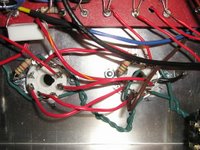

Saturday, May 13, 2006


Sound Clips: pentatonics and power chords
Ok- with fear and trepidation I post these clips. Hopefully they will highlight some of the cool sonic possibilities of this cool amp, and not distract you with my sub-par playing.
Here is my set-up for the sound clips (very atypical):
GUITAR: a 2001 Route 101 Solimar Custom; strat style with 2 Seymour Duncan hotrail pu's at the neck and bridge w/ a push-push coil-split on the tone pots to go from single to humbucker. SPEAKER CAB: funky Rickenbacker Road bass cab combo with amp torn out (see pic) and no-name 15" 8 ohm speaker I scrounged at my favorite music store here in Seattle The Tradingmusican.
RECORDING GEAR: mic- Samson Q1 condenser>Hosa mixer>Tascam US122 interface>iBook G4>Garageband>itunes>128kps mp3.
Clip 1- THE HUM: this is what my amp sounded like before I put in the 100 ohm filament hum reduction resistors. Painful, I know...
Clip 2- BLUES IN G: 2 track examp. of me playing a blues progession on rhythm with my guitar on neck pu and lead part on the bridge pu. Amp has one Electro Harmonix 6V6GT power tube in place and a GE 12AT7 in the preamp socket with the volume and tone set at 12:00. Boost switch set to 25uF cap.
Clip 3- POWER CHORD NOODLING: This is me noolding around with an RCA NOS 6K6GT power tube I got from Antique Electronic Supply (see pic). Same settings on amp, and various combinations of pu's on the guitar. I really like this little tube.
I think toward the end of the noodling clip, I moved the mic further away from the speaker cab and cranked it up to max. This thing puts out the volume. I really like how I can go from clean to dirty by adusting my volume on the guitar. With a 12AX7, you can get more crunch. I mainly prefer a blues/classic rock overdrive. I like finding speakers cheap and putting them into used amp combos, hence the 15" speaker. I think it breaks up great.
Thursday, May 04, 2006

HUMBUSTERS! Tracking down the noise.
With the help of my friend Greg, we were able to isolate some of the noise as coming from the heater wires (green pair). I'll have some before and after sound clips this weekend. As soon as I plugged it in, my friend said, "This is the same sound I had with my Princeton clone..."
We got onto the AX84 site and found a suggestion for putting to 100 ohm resistors in place to kill the noise (a.k.a "filament hum reduction resistors): http://annex.ax84.com/media/ax84_m314.pdf
This seemed to do the trick. There is still some slight noise, but very acceptable. See pic of the resistors below soldered off the pilot light to ground.

Saturday, April 29, 2006


SHE LIVES!!
After a long day of soldering, The Two-Stroke has come to life! I have run it with 2x6V6 and 1x6L6...how does it sound? Noisy- I think I have some ground loop issues and I forgot to connect the output jack to the 68k/1.5k connection. But overall, I am pleased with my initial efforts and like what I hear. I will be tweaking tomorrow an
 d hopefully put up some initial sound clips soon. Enjoy the photos. I will have more commentary on my grounding issues and
d hopefully put up some initial sound clips soon. Enjoy the photos. I will have more commentary on my grounding issues and 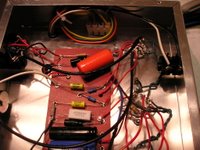
 power cord hook-up next entry. As to the picture of me fiddling with the amp on it's side-
power cord hook-up next entry. As to the picture of me fiddling with the amp on it's side-  I DON'T RECCOMEND YOU DO THIS- Hunter says that after the amp is built, don't mess with it unless you really know what you are doing- you can kill your self!! Even if it's unplugged.
I DON'T RECCOMEND YOU DO THIS- Hunter says that after the amp is built, don't mess with it unless you really know what you are doing- you can kill your self!! Even if it's unplugged. 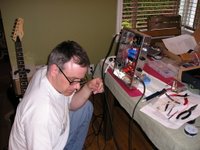
 Those cute little caps can hold high voltage charges for days EVEN WHEN THE POWER IS OFF TO THE AMP AND UNPLUGGED FROM THE WALL!
Those cute little caps can hold high voltage charges for days EVEN WHEN THE POWER IS OFF TO THE AMP AND UNPLUGGED FROM THE WALL!
Friday, April 28, 2006
1337 SOLDERING- DAY 1

Starting soldering my prepped parts as outlined on p. 189 in the book in the section "Order of Assembly." I've been able to follow the steps as they appear, so far. Steps 3 & 4 outlining how to mount the board in the chassis were different for my setup and I got hung up on step 6 since I don't have a brass grounding plate. More on grounding later....I'm pretty much up through step 11.
As you can see from the pictures, I haven't done alot and some of my solder joints are not pretty...
The blue OT primary wire was cut too short and I had to splice some yellow wire to make up the length- I hope this is not a noise issue. I also should have mounted my OT primary w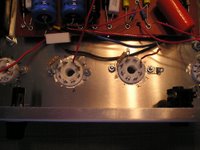 ires to come up through the chassis like he recommends near the 40uF cap. As you can see it's running all the way from the upper right corner in my layout. Also, it was a challenge to get the blue OT primary wire, red signal wire and 40uF cap lead and 10k resistor into that eyelet. Hunter mentions you may need to twist some wires around and work from there. I wish I would have stood off the big caps from the board to allow more room to work with my iron. This took several frustrating attempts to get the wires in place and I'm still not sure about that solder joint.
ires to come up through the chassis like he recommends near the 40uF cap. As you can see it's running all the way from the upper right corner in my layout. Also, it was a challenge to get the blue OT primary wire, red signal wire and 40uF cap lead and 10k resistor into that eyelet. Hunter mentions you may need to twist some wires around and work from there. I wish I would have stood off the big caps from the board to allow more room to work with my iron. This took several frustrating attempts to get the wires in place and I'm still not sure about that solder joint.
The wires from the boost switch, input jack and volume pot have been soldered to each other and to their respective places on the board. You can see the 1.5k resistors on pins 5 & 6 on the octal sockets- helps to have a heat sink or alligator clip to keep them in place while you solder.
My initial recommendation after Day 1 of 1337 soldering- MEASURE YOUR WIRE AND LEAD LENGTHS LONGER THAN YOU THINK YOU NEED THEM.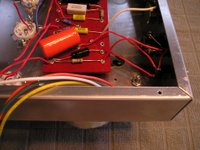 You can always cut them later.
You can always cut them later.
The sun is out in Seattle today (a rare occurance lately), so no amp soldering tonight.

Starting soldering my prepped parts as outlined on p. 189 in the book in the section "Order of Assembly." I've been able to follow the steps as they appear, so far. Steps 3 & 4 outlining how to mount the board in the chassis were different for my setup and I got hung up on step 6 since I don't have a brass grounding plate. More on grounding later....I'm pretty much up through step 11.
As you can see from the pictures, I haven't done alot and some of my solder joints are not pretty...
The blue OT primary wire was cut too short and I had to splice some yellow wire to make up the length- I hope this is not a noise issue. I also should have mounted my OT primary w
 ires to come up through the chassis like he recommends near the 40uF cap. As you can see it's running all the way from the upper right corner in my layout. Also, it was a challenge to get the blue OT primary wire, red signal wire and 40uF cap lead and 10k resistor into that eyelet. Hunter mentions you may need to twist some wires around and work from there. I wish I would have stood off the big caps from the board to allow more room to work with my iron. This took several frustrating attempts to get the wires in place and I'm still not sure about that solder joint.
ires to come up through the chassis like he recommends near the 40uF cap. As you can see it's running all the way from the upper right corner in my layout. Also, it was a challenge to get the blue OT primary wire, red signal wire and 40uF cap lead and 10k resistor into that eyelet. Hunter mentions you may need to twist some wires around and work from there. I wish I would have stood off the big caps from the board to allow more room to work with my iron. This took several frustrating attempts to get the wires in place and I'm still not sure about that solder joint.The wires from the boost switch, input jack and volume pot have been soldered to each other and to their respective places on the board. You can see the 1.5k resistors on pins 5 & 6 on the octal sockets- helps to have a heat sink or alligator clip to keep them in place while you solder.
My initial recommendation after Day 1 of 1337 soldering- MEASURE YOUR WIRE AND LEAD LENGTHS LONGER THAN YOU THINK YOU NEED THEM.
 You can always cut them later.
You can always cut them later.The sun is out in Seattle today (a rare occurance lately), so no amp soldering tonight.
Thursday, April 27, 2006

Prepping the pots, jacks, switches and misplaced component
Here are some pix of the tone/volume pots, boost switch and input jack with leads ready to fly to the circuit board or tubes. Notice the scorched fabric...what a newb! I burned the tablecloth and the kitchen table. "What's that I smell?!" The wife was not happy....the main soldering begins this evening.


Misplaced component- this is why you check 3 times and solder once. Notice the yellow .0047uF capacitor pointed out in the photo below. That cap is supposed to be grounded to the tone pot and the .47uF cap goes with the junction of the 25uF cap and 1.5k resistor as a bypass cap. That's the big orange drop you see popping out in 3-D. I didn't have a similar yellow style cap.


Friday, April 21, 2006
DAVE HUNTER RESPONDS! *READ THIS POST IF YOU ARE BUILDING THE 2 STROKE FROM SCRATCH*...
A couple of posts back, I cried out to Dave Hunter in cyberspace hoping he would hear my plea about a PT question I had...he has answered The Call. Mr. Hunter has graciously answered this question and provided critical information about changes to his original design since "The Guitar Amp Handbook" was published. You will want to read his comments before soldering your amp if you are building this amp using the book as your guide.
I have included email excerpts from Dave below. Some of his comments are information you would have if you purchase The Two-Stroke Amp Kit offered through Backbeat Books at this link: http://www.backbeatuk.com/ampkit/ampkit.htm. You can find the latest information about the amp design at this link and should seriously consider this option if you don't have at least 2 out of 3 of the following conditions met: 1) amp building experience; 2) a friend you can bug all the time about his previous amp projects; 3) a brother-in-law/friend/co-worker/self with access to tools for drilling.
That being said, Dave was kind enough to offer some very important Supplementary Build Notes to the amp and gave his permission for me to link this document you can only typically get when you purchase the kit. Thanks Dave!! Here is the link
Two-Stroke Amp Desgin: Supplementary Notes
Download this to get some very important and specific information about PT hook-up and other need-to-know details BEFORE YOU SOLDER.
Comments from Dave Hunter emails below-
April 19, 2006
I had a look at your amp kit blog: lovely work. I'm
impressed that you're building it from scratch from
parts you are sourcing yourself, but that is
definitely the best way to learn. I'm going to send
you an attachment of the Supplementary Instructions
document that I wrote up for the amp kit sales. There
are a few updates in that and a few minor corrections.
The 70ma PT should be fine (they change the specs on
these things without letting us know!), and the
instructions will also cover the extra wires that you
find on their newer PT compare with the one I
prototyped the kit with (again, these just started
turning up - nobody told me they'd changed them!).
People are having great success with this, though, so
you shouldn't have any problems.
Some people are finding a 20uF filter cap in place of
the first 40uF works best, makes the amp a little less
squasy because it reacts better with the 5Y3, but you
can always change that after if you feel you want to,
as long as you understand the safety practices
involved.
April 19, 2006
> Dave-
>
> Thanks for the response and the instructions!
>
> Quick question. I'm really only going use this amp
> with an 8 ohm speaker whether it's 10", 12" or 15".
> I only have one speaker out jack. Which OT wire
> should I use? I have plenty of room to add another
> jack if needed.
> -Ken in Seattle
Hi Ken,
WIth a single 8 ohm speaker and either 2x6V6 tubes or
a single 6L6 you want to use the white wire from the
OT secondary. If you sometimes want to use a single
6V6 change to the yellow wire, or put in a switch to
do so. Keeping it simple is always a good idea!
I forgot to say (but maybe it's in those notes) that
there was a mistake in the diagram such that the cap
on the Tone pot reads .047uF but it should actually be
the .0047uF that is correctly listed in the parts
list [p. 180 in the book].
Also, hopefully you understood this point but
one builder just emailed me who didn't, so... you DO
NOT connect pin 2 of V1 to ground - that's just to
indicate the connection for the shield of that
shielded wire to the ring terminal on the preamp tube
socket bolt.
All the best,
Dave
April 20,2006
> Dave-
>
> Many thanks for the OT advice. I noticed from the
> instructions you sent me, that you preferred the
> single 6L6 set up. I'm going to go with the two tube
> setup. And I did get the heads up about the .047uF
> cap…
> I wanted to tell you that I just finished reading
> your classic guitar rigs book and really thought it
> was fantastic. Before your book came out, a buddy of
> mine and I were complaining that there were no good
> reference recordings with all the amp and guitar
> settings explained. Thanks for making that CD. Also,
> your guitar amp book is the clearest, most
> articulate book of it's kind. I've been mining the
> internet for information like this. Your book
> brought it all together with common sense, a good
> dose of electronic theory, and engaging writing.
>
> thanks
>
> -Ken in Seattle
Hi Ken,
Thanks for your kind words about the books. I'm glad
you have found them informative. Re the 1x6L6 vs
2x6V6, since you've already punched a chassis for two
output tubes you might as well try the latter, and the
beauty is you can always swap the configurations
without changing anything because they are
individually biased, and the impedance match is the
same between on 6L6 and two 6V6s. When I say the 6L6
"sounded better" to me (albeit only slightly) that's a
subjective comment, and there are many cool things
about two 6V6s also. And even without an impedance
switch (which you could add easily) you can pull one
of the 6V6s for a half-power mode, and the OT won't be
all that bothered about the mismatch, even if it's not
an optimum situation in the purist's sense.
Good luck, and enjoy,
Dave
A couple of posts back, I cried out to Dave Hunter in cyberspace hoping he would hear my plea about a PT question I had...he has answered The Call. Mr. Hunter has graciously answered this question and provided critical information about changes to his original design since "The Guitar Amp Handbook" was published. You will want to read his comments before soldering your amp if you are building this amp using the book as your guide.
I have included email excerpts from Dave below. Some of his comments are information you would have if you purchase The Two-Stroke Amp Kit offered through Backbeat Books at this link: http://www.backbeatuk.com/ampkit/ampkit.htm. You can find the latest information about the amp design at this link and should seriously consider this option if you don't have at least 2 out of 3 of the following conditions met: 1) amp building experience; 2) a friend you can bug all the time about his previous amp projects; 3) a brother-in-law/friend/co-worker/self with access to tools for drilling.
That being said, Dave was kind enough to offer some very important Supplementary Build Notes to the amp and gave his permission for me to link this document you can only typically get when you purchase the kit. Thanks Dave!! Here is the link
Two-Stroke Amp Desgin: Supplementary Notes
Download this to get some very important and specific information about PT hook-up and other need-to-know details BEFORE YOU SOLDER.
Comments from Dave Hunter emails below-
April 19, 2006
I had a look at your amp kit blog: lovely work. I'm
impressed that you're building it from scratch from
parts you are sourcing yourself, but that is
definitely the best way to learn. I'm going to send
you an attachment of the Supplementary Instructions
document that I wrote up for the amp kit sales. There
are a few updates in that and a few minor corrections.
The 70ma PT should be fine (they change the specs on
these things without letting us know!), and the
instructions will also cover the extra wires that you
find on their newer PT compare with the one I
prototyped the kit with (again, these just started
turning up - nobody told me they'd changed them!).
People are having great success with this, though, so
you shouldn't have any problems.
Some people are finding a 20uF filter cap in place of
the first 40uF works best, makes the amp a little less
squasy because it reacts better with the 5Y3, but you
can always change that after if you feel you want to,
as long as you understand the safety practices
involved.
April 19, 2006
> Dave-
>
> Thanks for the response and the instructions!
>
> Quick question. I'm really only going use this amp
> with an 8 ohm speaker whether it's 10", 12" or 15".
> I only have one speaker out jack. Which OT wire
> should I use? I have plenty of room to add another
> jack if needed.
> -Ken in Seattle
Hi Ken,
WIth a single 8 ohm speaker and either 2x6V6 tubes or
a single 6L6 you want to use the white wire from the
OT secondary. If you sometimes want to use a single
6V6 change to the yellow wire, or put in a switch to
do so. Keeping it simple is always a good idea!
I forgot to say (but maybe it's in those notes) that
there was a mistake in the diagram such that the cap
on the Tone pot reads .047uF but it should actually be
the .0047uF that is correctly listed in the parts
list [p. 180 in the book].
Also, hopefully you understood this point but
one builder just emailed me who didn't, so... you DO
NOT connect pin 2 of V1 to ground - that's just to
indicate the connection for the shield of that
shielded wire to the ring terminal on the preamp tube
socket bolt.
All the best,
Dave
April 20,2006
> Dave-
>
> Many thanks for the OT advice. I noticed from the
> instructions you sent me, that you preferred the
> single 6L6 set up. I'm going to go with the two tube
> setup. And I did get the heads up about the .047uF
> cap…
> I wanted to tell you that I just finished reading
> your classic guitar rigs book and really thought it
> was fantastic. Before your book came out, a buddy of
> mine and I were complaining that there were no good
> reference recordings with all the amp and guitar
> settings explained. Thanks for making that CD. Also,
> your guitar amp book is the clearest, most
> articulate book of it's kind. I've been mining the
> internet for information like this. Your book
> brought it all together with common sense, a good
> dose of electronic theory, and engaging writing.
>
> thanks
>
> -Ken in Seattle
Hi Ken,
Thanks for your kind words about the books. I'm glad
you have found them informative. Re the 1x6L6 vs
2x6V6, since you've already punched a chassis for two
output tubes you might as well try the latter, and the
beauty is you can always swap the configurations
without changing anything because they are
individually biased, and the impedance match is the
same between on 6L6 and two 6V6s. When I say the 6L6
"sounded better" to me (albeit only slightly) that's a
subjective comment, and there are many cool things
about two 6V6s also. And even without an impedance
switch (which you could add easily) you can pull one
of the 6V6s for a half-power mode, and the OT won't be
all that bothered about the mismatch, even if it's not
an optimum situation in the purist's sense.
Good luck, and enjoy,
Dave
Tuesday, April 18, 2006

The Final Chassis Cuts
Went back out to my brother-in-laws shop tonight to get some help for the final cuts and holes to mount the transformers and circuit board.

We started with the power transformer, measured the dimensions and taped down a squre of blue tape for the dremel to follow. Shrill as a dentist drill, the dremel cut through the chasis thanks to the steady hand of my bro-in-law. It would have been
 much easier to use a transformer that mounted on the top, but I couldn't find a PT with the specs Hunter calls for. I'm grateful to have a family member with a shop and some tools...
much easier to use a transformer that mounted on the top, but I couldn't find a PT with the specs Hunter calls for. I'm grateful to have a family member with a shop and some tools...
Next we carefully measured the holes for the output transformer. Hunter mentions that the OT wires will go under the circuit board, but after looking at my friend's Princeton clone, I realized I had plenty of room to run the OT wires around the board.
Finally drilled the holes for the stand-offs to mount the circuit board. T
 he Radio Shack bolts were a bit too short for the
he Radio Shack bolts were a bit too short for the  the thickness of the
the thickness of the board, so we removed the washers. Everything fits great. Next- the fun b
board, so we removed the washers. Everything fits great. Next- the fun b egins- solder it all together.
egins- solder it all together.
Saturday, April 15, 2006
THE POWER TRANSFORMER HAS ARRIVED!!
The power tranny arrived...but not from Weber! It came from AES! It arrived as a back order when I got my output tranny from them. I have a question about the specification on this transformer. You may be able to see from the picture of the spec sheet that arrived with the PT, it says it's rated for 70ma...Dave Hunter says the transformer should be rated for 80ma?! Will this be problem?? I'm not sure.
when I got my output tranny from them. I have a question about the specification on this transformer. You may be able to see from the picture of the spec sheet that arrived with the PT, it says it's rated for 70ma...Dave Hunter says the transformer should be rated for 80ma?! Will this be problem?? I'm not sure.
DAVE HUNTER- ARE YOU OUT THERE? CAN YOU ANSWER MY PT TRANSFORMER QUESTION? HELP ME OBI WAN HUNTER, YOUR MY ONLY HOPE! (did I mention this is my first amp project....?)
As luck would have it, I received the PT at the end of the week of my Spring Break when I had time to devote to soldering this thing. Oh well...Happy Easter.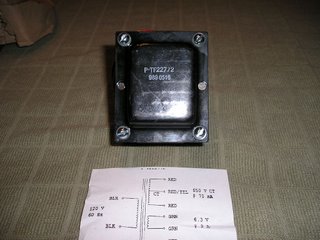
The power tranny arrived...but not from Weber! It came from AES! It arrived as a back order
 when I got my output tranny from them. I have a question about the specification on this transformer. You may be able to see from the picture of the spec sheet that arrived with the PT, it says it's rated for 70ma...Dave Hunter says the transformer should be rated for 80ma?! Will this be problem?? I'm not sure.
when I got my output tranny from them. I have a question about the specification on this transformer. You may be able to see from the picture of the spec sheet that arrived with the PT, it says it's rated for 70ma...Dave Hunter says the transformer should be rated for 80ma?! Will this be problem?? I'm not sure.DAVE HUNTER- ARE YOU OUT THERE? CAN YOU ANSWER MY PT TRANSFORMER QUESTION? HELP ME OBI WAN HUNTER, YOUR MY ONLY HOPE! (did I mention this is my first amp project....?)
As luck would have it, I received the PT at the end of the week of my Spring Break when I had time to devote to soldering this thing. Oh well...Happy Easter.

Saturday, April 08, 2006
Power Transformer from Weber
I've been waiting to order a Weber PT #W022772 from Weber Speakers (http://www.tedweber.com) but they have been out of stock...
I emailed Ted Weber and asked him when they would be in, hoping to reserve one. He emailed me back personally and said he would set one aside for me when they arrive. How cool is that?
Here is a link to the specs of the transformer from Ted's site: https://weberspeakerscom.secure.powweb.com/store/022772sch.jpg
I've been waiting to order a Weber PT #W022772 from Weber Speakers (http://www.tedweber.com) but they have been out of stock...
I emailed Ted Weber and asked him when they would be in, hoping to reserve one. He emailed me back personally and said he would set one aside for me when they arrive. How cool is that?
Here is a link to the specs of the transformer from Ted's site: https://weberspeakerscom.secure.powweb.com/store/022772sch.jpg
Sunday, April 02, 2006

DRILLING THE CHASSIS-
Today, with the help of my 2 brothers-in-law, we drilled the holes in the chassis for switches, pots, input jacks, ac plug, and tubes. As you can see from the pictures, my bro-in-law Jeff has all the tools we needed to do this right.
We started with a picture of Dave Hunter's prototype I printed off of the internet here: http://www.backbeatuk.com/ampkit/ampkit.htm
and layed it across the chassis, matching up swiches and pots according to the picture. We also looked at the schematic and decided to put the fuse holder on the back side next to the ac power cord jack. I'm also only using one speaker out jack vs. the 2 called out by Hunter.
 We drew a center-line guide with a sharpie, keeping the blue-plastic wrap on the chassis; center tapped the first hole for the boost switch and drilled away.
We drew a center-line guide with a sharpie, keeping the blue-plastic wrap on the chassis; center tapped the first hole for the boost switch and drilled away.
For the smaller holes, we used a regular drill bit. For the larger holes a stepped drill bit on a drill press.
 To make sure all holes were drilled correctly, we used a micrometer to get precise measurements and also made a mark on the stepped drill bit to make sure we didn't drill any holes too big...as you can see from the pix, my brothers-in-law are sacrificing their arms to aluminum shavings flying to and fro while I hide behind the camera (someone has to document all this...
To make sure all holes were drilled correctly, we used a micrometer to get precise measurements and also made a mark on the stepped drill bit to make sure we didn't drill any holes too big...as you can see from the pix, my brothers-in-law are sacrificing their arms to aluminum shavings flying to and fro while I hide behind the camera (someone has to document all this...
The trickiest hole was the ac power cord jack, since it is shaped like a rectangle. We drilled a big hole and then dremeled the rest to size.

Before drilling the holes for the tubes, we put the switches and pots and jacks in our new holes, placed the circuit board in the chassis, then lined up the ceramic tube sockets- marked with a sharpie and started drilling. We made
 sure the pin numbers corresponded with Hunter's schematic in the book. Finished up with some washers and screws to hold everything
sure the pin numbers corresponded with Hunter's schematic in the book. Finished up with some washers and screws to hold everything in place and- voila! It's starting to look like an amp. With the blue plastic shrink wrap removed, it's all polished aluminum. Very neat and clean. Thanks Jeff and Jim for all your hard work today! I just need to get that power transformer.
in place and- voila! It's starting to look like an amp. With the blue plastic shrink wrap removed, it's all polished aluminum. Very neat and clean. Thanks Jeff and Jim for all your hard work today! I just need to get that power transformer.


More pix of the front, back and inside.

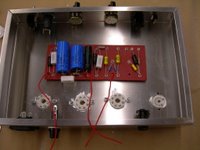

Subscribe to:
Comments (Atom)



